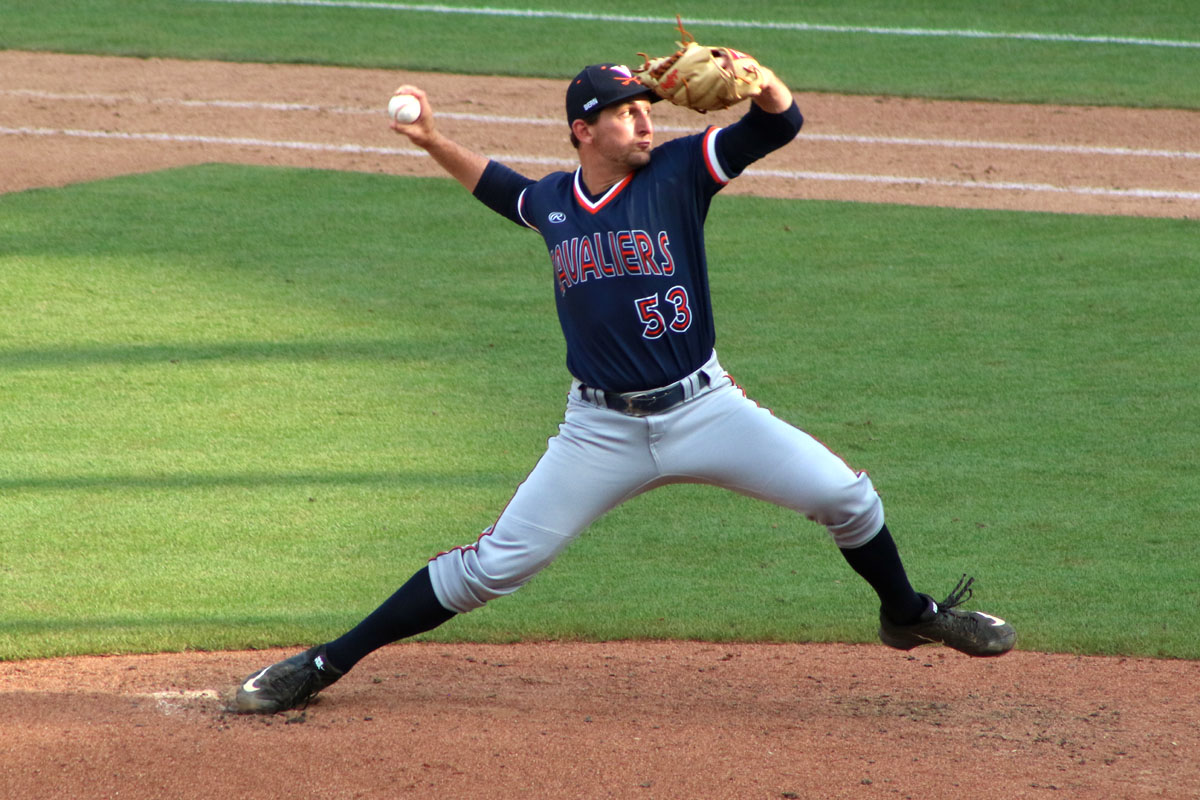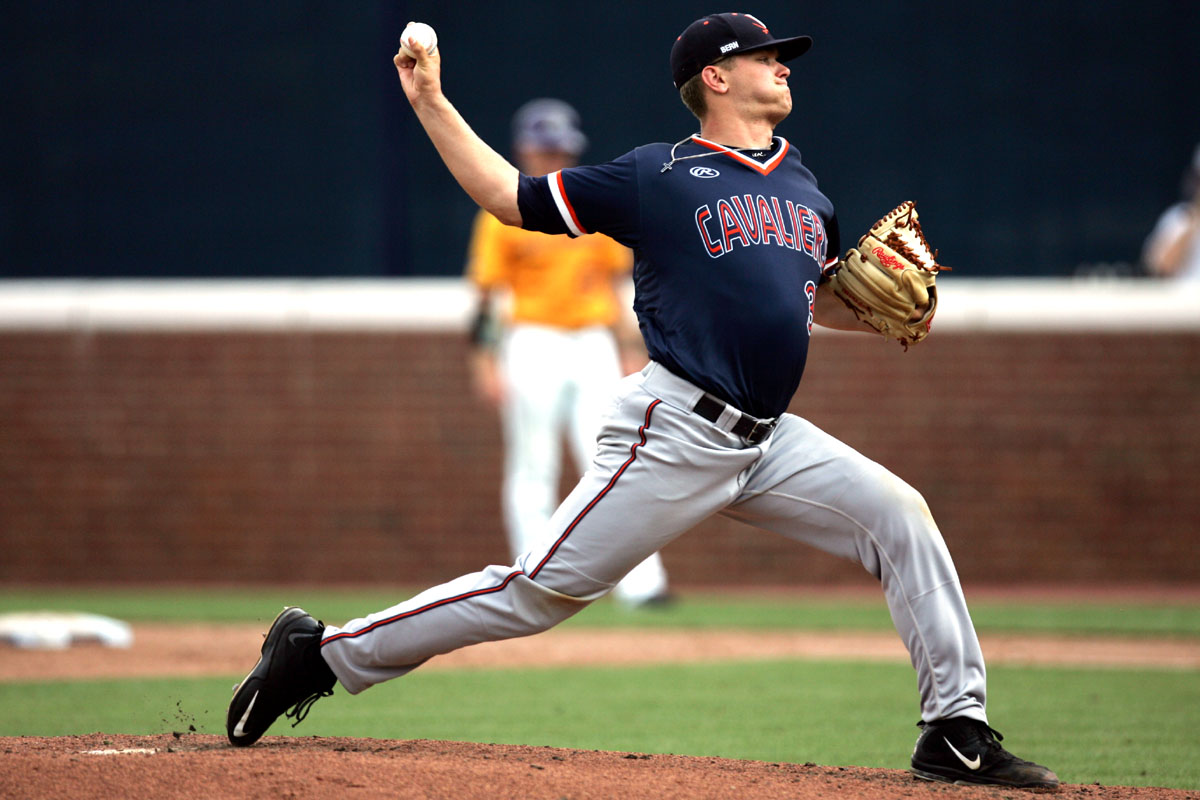
One of the things I think I love most about baseball is the cerebral nature of the game. There are so many decisions that are made throughout the course of a game and in baseball, as in so many sports, there are multiple options. Decisions that fans can speculate on what they would do. Decisions that can and will be second guessed. Decisions with plenty of Monday morning managing.
Two such decisions occurred in the final two innings of Virginia’s 8-6 walk-off loss to ECU on Saturday night. With the loss, the Hoos dropped to 1-1 in the double elimination NCAA Tournament regional and now must win three consecutive games to advance.
The first of big decision late in the game came in the bottom of the eighth of inning. Virginia led 6-3 with Tyler Shambora on the mound. Since relieving Connor Jones in the seventh, Shambora had retired five consecutive hitters, pitched UVA’s lone one-two-three inning, and had thrown just 19 pitches. Shambora was cruising and the Pirates seemed bedazzled. Then ECU’s Garrett Brooks reached base on a lead-off single.
Despite Shambora’s success up to that point, to the surprise of many, coach Brian O’Connor decided to make the move to closer Tommy Doyle. Doyle sent down the first three hitters he faced and Brooks was stranded at first when the eighth inning came to a close. Extended to a two-inning save opportunity, however, Doyle faltered in the ninth – more on that in a moment.
Back to Shambora. Since Virginia’s April 13th game against Longwood, Shambora has been lights out. In his last 23-2/3 innings, Shambora had surrendered three earned runs and 18 hits, posted a 15/6 K/BB ratio, and was sporting a 1.16 ERA. You read that right – a 1.16 ERA. Now, to be fair, Shambora ran into some trouble in the ACC Tournament giving up two earned runs in four innings of work.
So why not leave Shambora in after the lead-off single? That was the question posed to O’Connor after the game and he stuck to the strategy in the game plan vs. riding the hot hand in the eighth inning.
“Coach [Karl] Kuhn and I talked about it before the inning,” O’Connor said. “It was a save situation. We talked about it this morning that if we had an opportunity to win the ball game that we were going to use Tommy Doyle in the eighth inning. Where you run into dilemmas is, [Shambora] got the first runner on, all of sudden now, if the next guy gets on, now your bringing in your closer with runners on first and second, no outs. So the thought was to give him some wiggle room, which we did and fortunately it worked out. Tommy did a great job in the eighth and I don’t think the eighth has anything to do with the ninth. Tommy’s been trained to throw multiple innings as our closer. As it presented itself, I was even going to go to him in the seventh inning if I needed to.”
For managers or coaches these decisions often come down to either a gut feeling or going with what you know. In basketball, a similar decision with substitutions could come up. Do you go with a guard that has gone 3 for 3 from behind the arc in the second half of a Sweet Sixteen game for the stretch run or do you go with the guard who is 3 for 15 on the night but is your most consistent crunch time performer?
In the past, O’Connor has typically been a coach that goes with what he knows, what he’s seen work over time, and a consistent performer. This applies to closers from Casey Lambert to Josh Sborz. So what did O’Connor see in Doyle that would make him make the move to an early save chance?
Entering the game, Doyle was 1-1 with a 2.12 ERA in 13 games out of the bullpen with batters hitting .153 against him. In those 13 games, he’d allowed just four earned runs and had never allowed more than two earned runs in an outing – Doyle had a three-run lead when he entered against the Pirates. He also watched Doyle go two innings plus on four occasions during that span, giving up three earned runs total in those situations.
In his last seven relief appearances, the sophomore righty has gone 9.2 innings and allowed just one earned run. If you count the eighth inning of Saturday’s game, Doyle had gone 10.2 and allowed just one run – a 0.88 ERA.
But ECU’s Travis Watkins’ three-RBI BOMB in the bottom of the ninth erased all that really good stuff and that 0.88 ERA. And it opened up the decisions debate. For the record, I’m a go with the hot-hand kind of a guy (maybe that’s why I don’t coach) and I would have stayed with Shambora until the tying run came to the plate. But I haven’t won a gazillion baseball games and I don’t wear a CWS ring on my finger.
The second crucial decision came in the ninth inning as East Carolina had inched closer on the scoreboard. The Pirates sliced the Hoos’ 6-3 lead to just one run as Doyle’s second inning of work didn’t go smoothly. The first batter reached on an infield chopper that somehow found a safe spot to land and then three straight ECU hitters hammered the ball.
Single. Double. Single. After a sacrifice bunt, East Carolina was poised to tie or take the lead with runners at second and third with only one out.
Decision time again. Do you walk Watkins to load the bases and set up a potential game-ending double play? Do you leave the base open to give Doyle some wiggle room similar to the eighth inning because a walk would tie the game with the bases loaded?
Watkins was 0 for 4 on the day, but had gone 3 for 4 against Bryant in game one of the regional. Walking Watkins meant the coaches would be taking their chances with Garrett Brooks. He was 3 for 4 on the day and had barreled up balls on both starter Connor Jones and Shambora in the eighth. He went 2 for 4 with two RBI against Bryant too.
O’Connor decided to pitch to Watkins and the result was his only hit of the day – the game ending, walk-off home run. Decisions debate part two.
This one will keep me up at night because I think it goes in direct contradiction to what I believe the coaching staff has done in the past. Walk the runner to set up the double play. Watkins’ run ultimately didn’t matter. The runner on second was the winning run so why not set up the double play?
If Brooks was able to loft a ball, which he had not done all evening, then the Pirates tie the score but Virginia would only need one out to get out of the inning and extend to the game. Eric Tyler was up next and he had gone 0-3. If Doyle issues a walk to tie the game there, the double play is still open too.
I didn’t ask in the postgame but is this one where O’Connor went with his gut?
Again, here, my gut says I have a better chance of getting a fly ball out or a double play ball if I walk Watkins and pitch to Brooks. That and $6 will get you an expensive cup of coffee at one of those Frappuccino joints.

Regardless, those two decisions set up another one for 11 a.m. Sunday morning No, not over-easy or scrambled. Who do the Hoos start against William & Mary in the first elimination game of the day? UVA must win three times to get back to the Super Regional round.
Let me be clear, O’Connor and Kuhn have forgotten more in the last week about pitching than I have ever known. They’ve had more success with pitching in college baseball than anybody in the country in the last 13 years. But if I were running the show, this is how I would pitch the next three games.
Sunday, 11:00 a.m. game – Coach O’Connor always has been a believer in win the next game, but as he said following Friday’s win over the Tribe: “We’re here to win this thing, not to place.” If so, I believe that requires Adam Haseley being available against ECU in the 3 p.m. game. That means choosing a different starter for W&M.
I’m not saying Virginia can’t beat East Carolina with someone other than Haseley. What I am saying is that I think Virginia can beat William & Mary with its offense and piece together nine innings of pitching among guys like Kevin Doherty, Jack Roberts, David Rosenberger, and Bennett Sousa to name a few. Plus, with weather in play Sunday when it comes to strategy, I believe the first game is the best choice to try to split up innings around potential delays.
Sousa’s last three appearances were mid-week starts (last one at Liberty on May 3) and all of Roberts’ appearances have been from the pen. Rosenberger has started two games this season, including a solid effort against Wake Forest. But my “gut” says go with Doherty. His longest outing of the season was against Virginia Tech when he went four innings in relief of Jones for a save. If he could give the Hoos four innings against the Tribe as he did against the Hokies, I think the Hoos would be in pretty good shape.
Sunday, 3 p.m. game – If you can get to this game, you’ve got your third weekend starter Adam Haseley against ECU’s third starter as well. Plus, if needed, you can go to anyone who is available out of the pen, including Shambora and Doyle.
Monday, 6 p.m. Game – Daniel Lynch, who the Pirates tapped for six runs in a 6-1 win against UVA back on Feb. 27, and everyone who is available.
So often these decisions come down to a gut feeling or going with what you know and what you’ve seen from a player – demonstrated performance, if you will. Those decisions often prove to be the both the joy and agony of the game of baseball. Saturday night for O’Connor, the team, and Virginia fans, it was agony. But there’s that other great thing about baseball – you get to erase it all and play again the next day and in the Cavaliers’ case, hopefully they’ll play two.
Now you can second guess me. Hey – it’s baseball.



